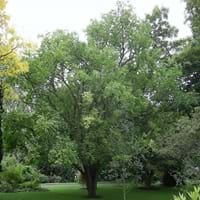Life Span
Annual and Perennial
Perennial
Type
Bulb or Corm or Tuber
Tree
Origin
Latin America and the Caribbean, Central America, Micronesia
China
Types
Hannah Yams, Japanese Sweet Potatoes
Not Available
Habitat
Cold Regions, Tropical regions
Dappled Shade, Sunny Edge, Woodland Garden Secondary
USDA Hardiness Zone
11-12
4-8
Sunset Zone
21,22
A1, A2, A3, H1, H2, 1a, 1b, 2a, 2b, 3a, 3b, 4, 5, 6, 7, 8, 9, 10, 11, 12, 13, 14, 15, 16, 17, 18, 19, 20, 21, 22, 23, 24
Habit
Vining/Climbing
Upright/Erect
Minimum Height
Not Available
Flower Color
Not Available
Yellow
Flower Color Modifier
Bicolor
Bicolor
Fruit Color
Not Available
White
Leaf Color in Spring
Green, Purple, Light Green, Chartreuse, Bronze
Green
Leaf Color in Summer
Light Green
Green
Leaf Color in Fall
Several shades of Green
Yellow
Leaf Color in Winter
Light Green
Not Available
Leaf Shape
Heart-shaped
Heart shaped, toothed with three to five lobes
Plant Season
Spring, Summer, Fall, Winter
Fall
Sunlight
Full Sun, Partial Sun
Full Sun
Growth Rate
Very Fast
Very Fast
Type of Soil
Clay, Loam, Sand
Clay, Loam, Sand
The pH of Soil
Acidic, Neutral, Alkaline
Acidic, Neutral, Alkaline
Soil Drainage
Well drained
Well drained
Bloom Time
Late Fall, Early Winter, Winter
Early Spring
Tolerances
Drought
Pollution, Drought, Salt, Soil Compaction
Where to Plant?
Ground, Pot
Ground
How to Plant?
Stem Cutting, Tuber propagation
Seedlings, Stem Cutting
Plant Maintenance
Medium
Medium
Watering Requirements
Average Water Needs, Needs a lot of water initially
Needs small amount of water
In Summer
Lots of watering
Lots of watering
In Spring
Moderate
Moderate
In Winter
Average Water
Average Water
Soil pH
Acidic, Neutral, Alkaline
Acidic, Neutral, Alkaline
Soil Type
Clay, Loam, Sand
Clay, Loam, Sand
Soil Drainage Capacity
Well drained
Well drained
Sun Exposure
Full Sun, Partial Sun
Full Sun
Pruning
Remove damaged leaves, Remove dead branches, Remove dead leaves
Remove damaged leaves, Remove dead branches, Remove dead leaves
Fertilizers
All-Purpose Liquid Fertilizer
Apply 10-10-10 amount
Pests and Diseases
Aphids, Beetles, Leafminers, Red blotch
Armillaria root rot, Bacterial Blight
Plant Tolerance
Drought
Drought
Flowers
Showy
Insignificant
Flower Petal Number
Single
Single
Foliage Texture
Coarse
Medium
Foliage Sheen
Matte
Matte
Invasive
Sometimes
Sometimes
Attracts
Aphids, Beetles, Mites, white worms
Insects, Silkworms
Allergy
Abdominal pain, Skin rash, Swelling, Vomiting
Pollen, Severe allergen
Aesthetic Uses
Not Used For Aesthetic Purpose
Not Used For Aesthetic Purpose
Beauty Benefits
Not Available
Hair-growth, Skin whitening
Environmental Uses
Air purification
Air purification
Medicinal Uses
Potassium, ß-carotene, Vitamin C
Analgesic, Anthelmintic, Antibacterial, Astringent, Diuretic, Expectorant, Odontalgic
Part of Plant Used
Leaves, Root, Shoots
Fruits, Inner Bark, Leaves
Other Uses
Used As Food, Used for its medicinal properties
As a tea substitute, Used as a thickener in soups, Used to make baskets
Used As Indoor Plant
Yes
No
Used As Outdoor Plant
Yes
Yes
Garden Design
Container, Edible, Groundcover, Hanging Basket, Herb / Vegetable, Mixed Border, Vine
Shade Trees, Street Trees
Botanical Name
IPOMOEA batatas
MORUS alba
Common Name
Sweet Potato, Sweet Potato Vine
White Mulberry
In Hindi
शकरकंद
सफेद शहतूत
In German
Süßkartoffel
Weiß Mulberry
In French
Patate douce
Mûrier blanc
In Spanish
Batata
White Mulberry
In Greek
Γλυκοπατάτα
Λευκή Μουριά
In Portuguese
Batata doce
Branco Mulberry
In Polish
Słodki ziemniak
Biały Mulberry
In Latin
Dulcis SOLANUM TUBEROSUM
Morus alba
Phylum
Magnoliophyta
Magnoliophyta
Class
Magnoliopsida
Magnoliopsida
Order
Solanales
Urticales
Family
Convolvulaceae
Moraceae
Clade
Angiosperms, Asterids, Eudicots
Not Available
Tribe
Not Available
Moreae
Subfamily
Not Available
Not Available
Number of Species
Not Available
Season and Care of Sweet Potato and White Mulberry
Season and care of Sweet Potato and White Mulberry is important to know. While considering everything about Sweet Potato and White Mulberry Care, growing season is an essential factor. Sweet Potato season is Spring, Summer, Fall and Winter and White Mulberry season is Spring, Summer, Fall and Winter. The type of soil for Sweet Potato is Clay, Loam, Sand and for White Mulberry is Clay, Loam, Sand while the PH of soil for Sweet Potato is Acidic, Neutral, Alkaline and for White Mulberry is Acidic, Neutral, Alkaline.
Sweet Potato and White Mulberry Physical Information
Sweet Potato and White Mulberry physical information is very important for comparison. Sweet Potato height is 60.00 cm and width Not Available whereas White Mulberry height is Not Available and width Not Available. The color specification of Sweet Potato and White Mulberry are as follows:
Sweet Potato flower color: Not Available
Sweet Potato leaf color: Green, Purple, Light Green, Chartreuse and Bronze
White Mulberry flower color: Yellow
- White Mulberry leaf color: Green
Care of Sweet Potato and White Mulberry
Care of Sweet Potato and White Mulberry include pruning, fertilizers, watering etc. Sweet Potato pruning is done Remove damaged leaves, Remove dead branches and Remove dead leaves and White Mulberry pruning is done Remove damaged leaves, Remove dead branches and Remove dead leaves. In summer Sweet Potato needs Lots of watering and in winter, it needs Average Water. Whereas, in summer White Mulberry needs Lots of watering and in winter, it needs Average Water.





